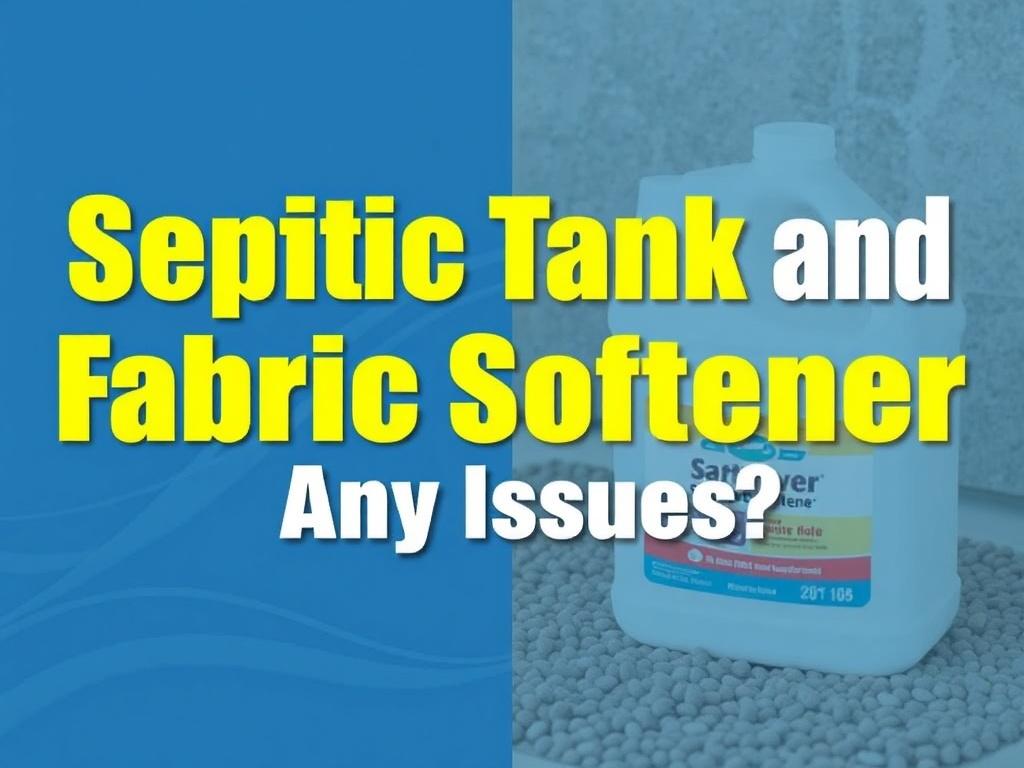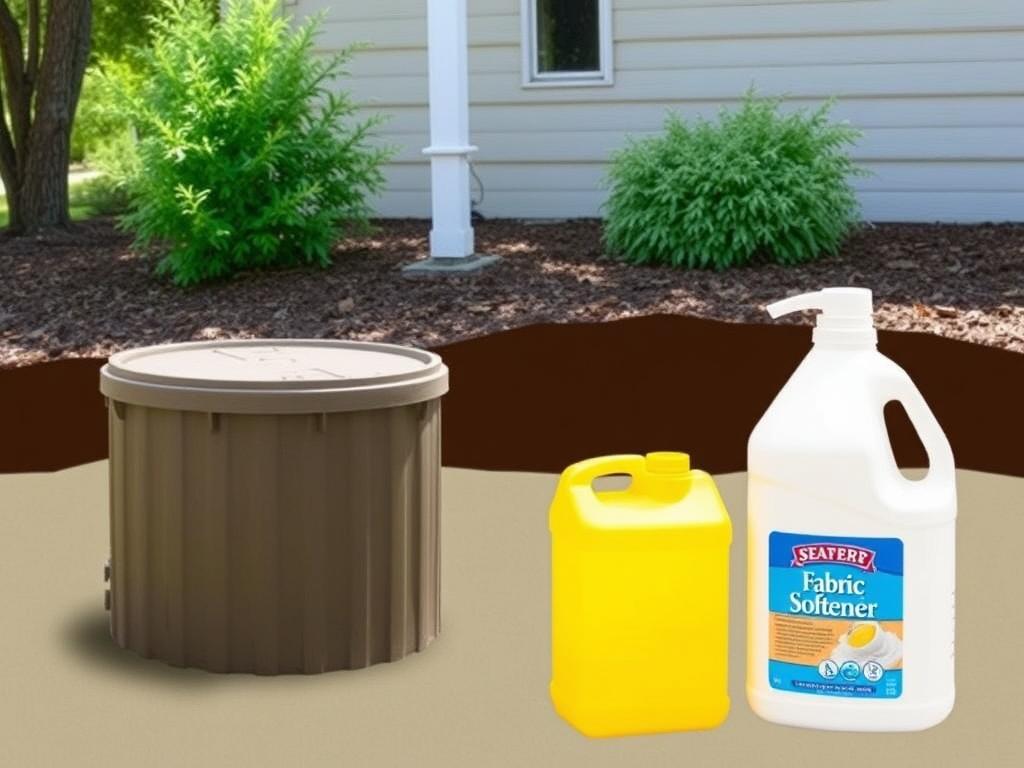When it comes to maintaining a septic tank, homeowners often wonder if everyday household products, like fabric softeners, could cause problems. Fabric softener is a staple in many laundry routines, prized for leaving clothes feeling soft and smelling fresh. However, the question that often arises is: can fabric softener harm a septic tank? If you’re curious about this, you’re not alone. Understanding the relationship between septic tanks and fabric softeners is essential for keeping your system healthy and avoiding costly repairs.
A septic tank is an underground wastewater treatment system commonly used in areas where centralized sewer systems aren’t available. It relies on natural processes and bacteria to break down and safely dispose of household waste. Fabric softeners, on the other hand, are chemical concoctions designed to make fabrics softer and reduce static cling. Since septic tanks depend on beneficial bacteria to function, there is a growing concern about whether the chemicals in fabric softeners might disrupt these bacteria and, by extension, impair the septic system.
In this article, we’ll explore the nitty-gritty of how fabric softeners interact with septic tanks. We’ll look at the chemistry behind fabric softeners, how septic tanks work, and which ingredients in fabric softeners may be problematic. We’ll also discuss safe practices for using fabric softeners if you have a septic system, alternatives that are more septic-safe, and tips for maintaining your septic tank health without sacrificing laundry freshness. Let’s dive in.
- How Does a Septic Tank Work?
- The Role of Household Chemicals in Septic Systems
- What Is Fabric Softener Made Of?
- Can Fabric Softener Harm Your Septic Tank?
- Scientific Perspective
- The Practical Reality
- Experts’ View on Fabric Softener and Septic Tanks
- Septic-Safe Fabric Softener Alternatives
- Natural Fabric Softening Options
- Homemade Fabric Softener Recipes
- Best Practices for Fabric Softener Use with Septic Systems
- Signs Your Septic System Might Be Struggling
- Common Misconceptions About Fabric Softener and Septic Tanks
- Summary Table: Pros and Cons of Fabric Softener Use on Septic Systems
- Conclusion
How Does a Septic Tank Work?
Before we analyze the potential impact of fabric softeners on septic tanks, it’s important to understand the basics of how septic systems operate. A typical septic tank system has three main components:
- Septic Tank: This underground tank temporarily holds wastewater from your home. The solid waste settles at the bottom forming sludge, while lighter materials like oils and grease float to the top, called scum.
- Bacteria and Anaerobic Digestion: Naturally occurring bacteria inside the tank break down the solid waste through a process called anaerobic digestion. This reduces the volume of sludge and prevents blockages.
- Drain Field (Leach Field): The partially treated wastewater flows from the septic tank through perforated pipes into a drain field, where microbes in the soil further clean it before it seeps into the groundwater.
The success of a septic system heavily depends on the balance and activity of bacteria inside the tank. Any substances that kill or inhibit these helpful bacteria can disrupt waste breakdown, leading to backups, odors, and costly repairs.
The Role of Household Chemicals in Septic Systems
Household chemicals are frequently introduced into septic systems through everyday usage—cleaning products, detergents, and yes, fabric softeners. Many people don’t realize that what goes down their drains may either be harmless or significantly detrimental to septic system health.
Chemicals that are harsh or toxic can kill the essential bacteria responsible for waste decomposition. Common culprits include bleach, antibacterial soaps, and some detergents with phosphorus or artificial fragrances. Understanding the chemical composition of products like fabric softeners is key to determining their impact.
What Is Fabric Softener Made Of?
Fabric softeners come in liquid, sheet, or ball forms and typically contain several key components to soften fabrics and add fragrance:
| Component | Function | Potential Septic Impact |
|---|---|---|
| Quaternary Ammonium Compounds (Quats) | Provide softness and antistatic properties. | Can be biocidal, potentially harming bacteria in septic tanks. |
| Fragrances | Add scent to laundry. | Usually harmless in small amounts, but synthetic fragrances may contain chemicals that disrupt bacteria. |
| Emulsifiers | Help spread the softening agents evenly on fabric. | Generally biodegradable, but excessive use could contribute to chemical load. |
| Preservatives | Extend shelf life. | Some preservatives may inhibit bacterial activity. |
| Conditioning Agents | Coat fabric fibers for a soft feel. | May break down slowly, but impact varies by product. |
Looking at these ingredients, the quaternary ammonium compounds (quats) stand out because they have antimicrobial properties, meaning they can kill or inhibit the growth of bacteria. Since septic tanks rely on bacteria to break down waste, this raises a red flag.
Can Fabric Softener Harm Your Septic Tank?

The concern most often voiced is whether the antimicrobial agents in fabric softener can harm the septic tank bacteria. The answer isn’t straightforward because it depends on several factors such as the amount of fabric softener used, the type of septic system, soil type, and the overall maintenance of your septic tank.
Scientific Perspective
Studies on the effects of fabric softeners on septic tank bacteria show varied results. Some laboratory analyses indicate that quats in fabric softeners can reduce bacterial populations, but only at high concentrations. In most household uses, fabric softener is diluted with wastewater, which lessens its microbial toxicity.
Moreover, septic systems with healthy bacterial colonies and functioning drain fields can often tolerate small amounts of fabric softener without damage. However, over time, consistent excessive use may cumulatively affect bacterial activity.
The Practical Reality
In everyday life, fabric softener is not typically the main culprit behind septic issues. Problems more often arise from harsh cleaning chemicals, oils, grease, excessive water use, or lack of regular tank pumping. Still, here’s a quick breakdown of possible effects of fabric softener on septic tanks:
- Minor Bacterial Disruption: Quats may slightly reduce bacterial numbers temporarily but usually do not destroy entire bacterial ecosystems.
- Foaming Issues: Some fabric softeners can create foam during washing, which may interfere with septic tank settling and sludge separation.
- Accumulation of Chemicals: Repeated use over time can lead to a buildup of synthetic compounds that slow bacterial processes.
- Drain Field Impact: If chemicals reach the drain field, they might affect soil microbes needed for final wastewater treatment.
Experts’ View on Fabric Softener and Septic Tanks
Many septic system professionals advise caution but don’t categorically ban fabric softeners. Their general recommendations include:
- Use fabric softeners sparingly if you have a septic tank.
- Choose products labeled as “septic-safe” or biodegradable.
- Alternate laundry days to avoid overloading the system.
- Monitor your septic tank for signs of trouble such as slow drains or odors.
- Schedule regular inspections and pumping to maintain healthy bacterial populations.
Septic-Safe Fabric Softener Alternatives
If you’re concerned about the long-term effects of fabric softeners on your septic tank, there are effective alternatives that can keep your laundry soft and fresh without introducing harmful chemicals.
Natural Fabric Softening Options
Here are some household items that can replace traditional fabric softeners:
| Alternative | How It Works | Septic Safety |
|---|---|---|
| White Vinegar | Neutralizes odors and softens fabric by breaking down detergent residues. | Biodegradable and safe for septic systems. |
| Baking Soda | Balances pH and helps freshen laundry. | Septic-safe in moderate amounts. |
| Wool Dryer Balls | Reduce static and soften clothes naturally during drying. | Completely safe, no chemicals involved. |
| Essential Oils | Add natural fragrance when added to vinegar or wool balls. | Generally safe when used sparingly. |
Homemade Fabric Softener Recipes
You can easily mix your own fabric softener using natural ingredients. Here’s a simple recipe that is gentle on septic systems:
- 2 cups white vinegar
- 2 cups water
- 20-30 drops of your favorite essential oil (optional)
Mix these ingredients in a spray bottle or use a cup in the rinse cycle for soft, odor-free laundry.
Best Practices for Fabric Softener Use with Septic Systems

Even if you prefer to use commercial fabric softeners, adopting best practices can help minimize any negative impact on your septic tank:
- Use Moderation: Don’t overuse fabric softener. A small amount per load goes a long way.
- Choose Biodegradable Products: Look for labels indicating the product is safe for septic systems.
- Dispense Properly: Add fabric softener directly to the washer dispenser to ensure proper dilution.
- Avoid Multiple Chemical Loads: Don’t wash all laundry with fabric softener every time. Mix up your laundry cycles with plain detergent loads.
- Maintain Your Septic Tank: Pump your tank regularly (every 3-5 years) to remove sludge buildup.
Signs Your Septic System Might Be Struggling

Regardless of fabric softener use, it’s important to keep an eye on your septic system’s health. Here are some warning signs that you might have a problem:
| Sign | What It Indicates | Recommended Action |
|---|---|---|
| Slow Drains or Backups | Possible tank clog or drain field blockage. | Contact a septic professional for inspection and pumping. |
| Bad Odors Around Tank or Drain Field | Wastewater surfacing due to poor treatment. | Call a septic technician immediately. |
| Wet or Soggy Areas in Drain Field | Drain field not absorbing liquids properly. | Stop water use in the area, seek repairs. |
| Unusually Green or Lush Grass Over Drain Field | Excess nutrients or moisture leaking from the system. | Have the system checked, avoid heavy water use. |
Common Misconceptions About Fabric Softener and Septic Tanks
There are a few myths floating around that can confuse homeowners. Let’s clear up some of the most common misconceptions:
- Myth: Fabric softeners will immediately ruin my septic tank.
Reality: Occasional use typically won’t cause significant harm if your septic system is healthy and well maintained. - Myth: Natural or homemade fabric softeners are always safer.
Reality: While generally gentler, even natural substances can impact bacteria if used excessively. - Myth: Softener sheets flushed down the toilet are safe.
Reality: Never flush dryer sheets or fabric softener sheets; they do not dissolve properly and can clog your septic tank and pipes.
Summary Table: Pros and Cons of Fabric Softener Use on Septic Systems
| Pros | Cons |
|---|---|
|
|
Conclusion
In the balancing act of household convenience and septic system health, fabric softeners occupy a visible but manageable position. While some ingredients in conventional fabric softeners, especially quaternary ammonium compounds, can potentially disrupt the beneficial bacteria crucial for septic tank operation, typical household use usually does not pose a severe threat to a well-maintained system. Moderation in use, choosing septic-safe or biodegradable softeners, and regular septic tank care will help ensure your septic system remains in good shape while your laundry stays soft and fresh. Alternatively, natural fabric softening methods like vinegar, baking soda, or wool dryer balls provide gentle and environment-friendly options that further reduce any risk. Ultimately, awareness and mindful product choices paired with consistent septic maintenance are the keys to enjoying both clean clothes and a trouble-free septic system.
Помогла вам статья?






